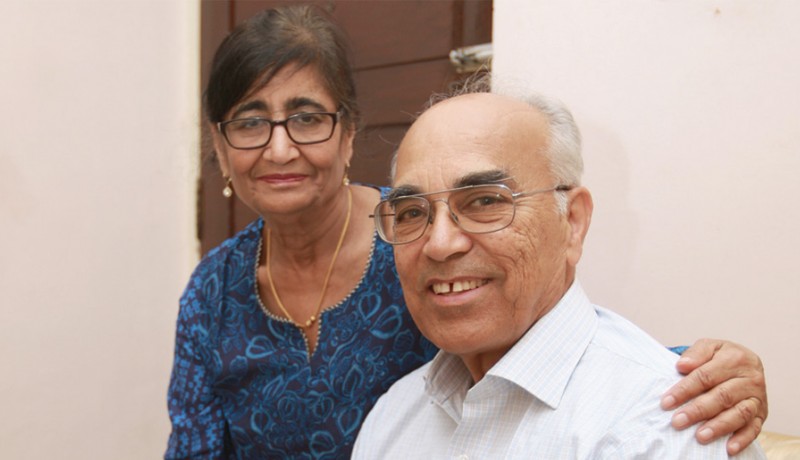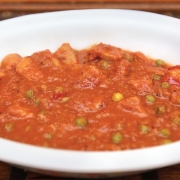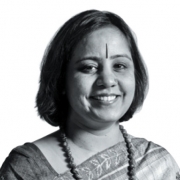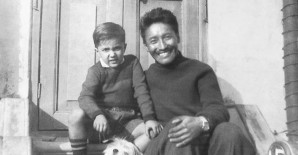
Columns

A series by Pratibha Jain about silvers who believe nurturing the body and mind is the key to joy.
Featuring Champa & Brij Bhushan from Virginia, US
They have both been engineering students; they have both been teachers; and they have also worked together in their own company. Their common interests extend further—to travelling, gardening and cooking. When they speak, you hardly notice when one stops and the other takes over. They also hold the distinction of being the first-ever couple to be married in Pilani while teaching there.
Young Brij Bhushan earned his bachelor’s in electrical engineering from BITS Pilani in1964. After her BE in electronics and communications from Jadhavpur University, Champa pursued her master’s at BITS Pilani. Both chose to teach at the university thereafter and, by a strange twist of fate, met, fell in love, and got married!
Now in their early 70s, Champa and Brij Bhushan live in a beautiful house in the suburbs of Washington DC. Being health-conscious, they have meticulously discovered the right foods to eat and the perfect way to cook. They cherish their close circle of friends and are known for their warmth and hospitality. I met them recently on their visit to Chennai during their India trip. Having heard much about their culinary skills and hospitality from Brij’s cousin Sulakshanaji, I was excited about the meeting. Here are some snippets of my conversation with them.
IN THEIR OWN WORDS
Champa: I am a Sindhi and Brij is Punjabi. I landed in Pilani as my brother, teaching there, was feeling homesick owing to a lack of home-cooked meals! I enrolled for my master’s in electrical engineering and later took up a teaching job there. The rest is history! We now live in the suburbs of Washington DC and have three grown-up children, Anju, Anita and Anup.
Brij Bhushan: My father was in the Central Government, hence he moved often. We have lived across the stretch of North India: Rajasthan, UP (Meerut), Bihar (Patna), Orissa, West Bengal. After marriage, we proceeded to the USA for higher studies. I worked in Bell Canada during the 1970s. We moved to Washington DC in 1980 and I started my own company in 1986, Reston Consulting Group, which provides systems integration services in the field of telecommunications to the US Federal Government. Champa joined our business in 1993 after a stint of corporate employment in telecommunications companies.
She: I was ahead of my times in not just having had an inter-caste marriage but choosing a career path where girls feared to tread. I was always goal-oriented and being the only girl student in my university class did not faze me. A comment by one of my teachers propelled me towards engineering. She said, “If you were a boy, you would be ideally suited for engineering!”
KITCHEN INSPIRATION
He: My father was a gardener at heart. Wherever we lived, he always grew something in the kitchen garden! When he visited us here in US, he enjoyed gardening in our patch. Now my brother Kul Bhushan takes over the gardening during his frequent visits to the US.
She: He once grew so much of bottle gourd that even after cooking, freezing and distributing to friends, there was a lot still left!
He: We now grow anything and everything but potatoes and onions. I personally dislike eating potatoes. There is a story behind this: While studying in Pilani, the hostel mess cooks put potatoes in every single meal every single day! Having had an overdose of potatoes for five years while a student at Pilani, I nearly swore off potatoes for good.
CHALLENGES IN A NEW COUNTRY
She: In 1969, when we moved to the US, few stores stocked ingredients—spices, dals, fresh vegetables—for Indian food. Whenever we discovered a store that did so, even during our travels, we would buy them and stock up. Those days, we would generally get them via mail order from a city that had enough Indians to have Indian stores. Of course, times have changed. This challenge further sparked our interest in cooking.
SECRET CULINARY MANTRA
He: Every vegetable you cook has its own oil in addition to the flavours. To enjoy and benefit from the natural flavours, do not overload the dish with oil, salt and spices.
She: I completely agree! I developed gall bladder stones, so cooking with minimal oil has been our secret mantra for years. We use canola or corn oil as it is low on cholesterol. Cooking healthy has become a way of life for us.
ALL-TIME FAVOURITES
She: Our dahi vadas are an all-time favourite with the family and friends! We tried baking the vadas, but we are yet to tweak the recipe to perfection.
He: During harsh winters in the US, we always make fresh dal and sabzi. At other times, we use our frozen veggies, but rotis daily at home are always made fresh! Thursdays used to be aloo paratha day in the family while the children were young, but now it is pizza day at home.
PASSIONS AND PASTIMES
He: I indulge my passion for gardening in part of the 2.5 acre of land behind our house. We eat the fresh produce, distribute some to our friends and freeze any leftovers for use in winters.
She: With time, we have discovered the best tricks to freeze veggies successfully. We would love to share some of the tips we have mastered! Brij is really methodical about this.
He: To freeze tomatoes, remove the stems, quarter them, put them in packets, label and freeze. When required, take out, thaw, blend into a smooth consistency and use in soups, dals and vegetables. To freeze lady’s finger [okra/bhindi], chop into quarter-inch pieces, spread on a flat pizza tray in a single layer and place the trays in the freezer for an hour. Remove, put into packets, label and freeze. When cooking the frozen bhindi, thawing is optional, not compulsory. Always cook the bhindi sabzi in an open skillet for best results.
TRIED AND TESTED TIPS
He: We have mastered the art of making curd [yoghurt] without the lace. Make a small amount of curd in a cup in the first round. Use this first curd as culture for the second cup of milk. Then use this second cup of formed curds as culture for the third cup of milk. The 4th generation curd will be thick and without any lace. Experimentation and observation has taught us a few things for sure!
DISASTER MANAGEMENT
She: When you are a cook, a culinary disaster is waiting to happen, especially if your attention wanders while cooking! If a dish starts to burn and smell, fill up the sink or a larger container partially with cold water and submerge the pan, with the burnt dish, in the cold water. This will help loosen the burnt portion from the bottom of the pan. After 2-3 minutes, scoop out the un-burnt portion from top and discard the rest. The scooped up dish will not have a burnt odour, and no one will ever know!
AWAY FROM HOME
She: In the US, we now get all vegetables fresh, year round. However, we miss the taste and flavour of fresh Indian vegetables we have eaten in our growing years! When we visit India, we binge on all the local fresh vegetables and ingredients.
He: The taste of Indian vegetables is always different than what we get in the US, a result of different soil, fertiliser and the environment.
She: Living away from India, it is important to have your own circle of friends and loved ones. We are all there for each other.
He: For us, our friends form our family and comfort zone away from our children.
CHANGING VALUES
He: Values have to evolve no matter where you live! Children eventually arrive at their own value system. They start by observing and absorbing what they see us do, but somewhere along the way, they create their own. Having grown up in the US, our children have had a very different kind of exposure. They have seen an amalgamation of diverse people.
She: It is different in India. India boasts of a strong value system where children grow up knowing that they have to take care of their parents.
He: We can see this now in the US too. Family leave laws in the US started with giving women maternity leave, then paternity leave for men and now we have family medical leave assistance that can be used for elder needs. This creates interdependency and bonding amongst generations.
She: In the US, we have learned to manage the household completely by ourselves without any domestic help, making us more individualistic and self-reliant unlike in India where household help is generally available.
It is rare to come across a couple so refreshing and well tuned in life as Champa and Brij Bhushan! The meeting of minds may have given them a head-start, but what keeps the magic alive are their similar passions, beliefs, values and their childlike attitude of disagreeing only to agree!
JIMIKAND MATAR KI SABZI
(Elephant yam and peas curry)
A favourite in the Bhushan household, this is a delicious sabzi using elephant yam and peas. Brij says one of his cravings is to eat this in India where it is freely available. It has been banned in the US since the FDA, which regulates food supply and safety, discovered it has certain natural chemical properties that can be used to make hallucinatory drugs. However, it is also known to have beneficial properties, which makes it an excellent lactate. It is also useful in the treatment of piles.
Ingredients
- Elephant yam (suran or jimikand): ¼ kg
- Shelled peas: 2 cups
- Chilli powder: 1 tsp
- Turmeric powder: ¼ tsp
- Coriander power: 1 tbsp
- Garam masala: ¼ tsp
- Salt to taste
For the paste
- Onion: 1; large
- Green chilli: 1; deseeded to reduce heat
- Tomatoes: 2; large
- Ginger: 1-inch piece
For the tempering
- Coconut oil: 1 tbsp
- Mustard seeds: ½ tsp
- Cumin seeds: ½ tsp
- Curry leaves: a sprig
Ingredients
Grind the onions and green chilli and set aside. Grind the tomatoes and ginger and set aside. Wash the yam well, remove the outer skin and chop into medium-sized bits. Wash well. Heat the oil in a pan. Add the mustard seeds; as they begin to splutter, add the cumin seeds, asafoetida and curry leaves. Add the onion paste and red chilli powder and fry until the raw smell disappears. Add the chopped yam and peas along with a cup of water. Cover and cook until the yam is cooked. Now, add the tomato paste along with turmeric and salt. Cook for 5-7 minutes. Add the coriander powder and garam masala. Stir well and switch off the flame. Serve hot with fresh rotis. You can substitute the yam in the above dish with potatoes or turnip.
Pratibha Jain, an author and translator from Chennai, is the co-author of two award-winning books Cooking at Home with Pedatha and Sukham Ayu. Her area of specialisation is documenting Indian traditions through research, translation and writing
Photos: Chennai Pix Featured in Harmony — Celebrate Age Magazine March 2017
you may also like to read
-
Mental workout
Mukul Sharma tells you how to keep those grey cells ticking Everyone will ultimately lose his or her brain….
-
Helpline
Dr Harshbir Rana answers your queries on personal and social issues related to ageing, elder care and intergenerational relationships ….
-
Off the cuff
Raju Mukherji pays tribute to his first hero, Tenzing Norgay, an exemplary mountaineer Darjeeling, 1955. Dr ‘Pahari’ Guha Mazumdar….
-
Yoga RX
Shameem Akthar shows ways to control debilitating ankle pain through regular practice Ankle pain is so common and prevalent….









